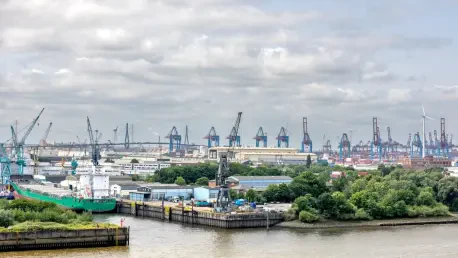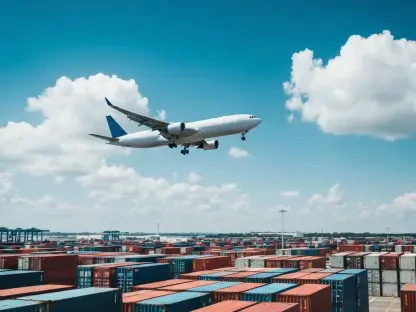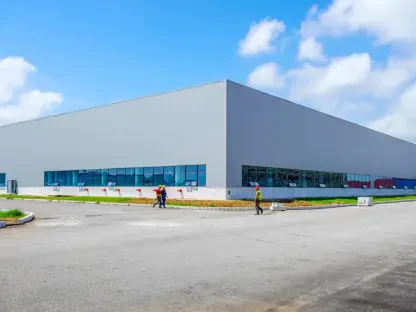Picture a bustling harbor where massive cargo ships glide silently, trucks hum with electric power, and the air is free from the choking haze of diesel fumes. This vision is not a distant fantasy but a tangible goal for the Ports of Los Angeles and Long Beach, the nation’s busiest maritime gateways, as they embark on a transformative mission to achieve zero-emission cargo operations by 2029. As of 2025, these twin ports are deep into this ambitious plan, with a deadline that could redefine global trade’s environmental footprint. What drives this unprecedented push, and how will it reshape life for millions in Southern California?
The stakes are monumental. Handling nearly 40% of the country’s containerized imports, these ports are economic powerhouses but also major contributors to air pollution in the South Coast region. The shift to zero emissions isn’t just about cleaner skies; it’s a lifeline for nearby communities long burdened by health issues tied to poor air quality. This initiative, backed by a binding agreement with the South Coast Air Quality Management District (South Coast AQMD), marks a historic pivot from voluntary efforts to enforceable action, promising a healthier future while maintaining economic vitality.
A Bold Leap Toward Sustainability
The journey to zero emissions at these ports represents one of the most ambitious environmental commitments in the shipping industry. A cooperative agreement, finalized with South Coast AQMD, sets strict deadlines for infrastructure development, targeting full zero-emission operations within the next four years. Unlike past voluntary measures, this plan carries significant penalties for noncompliance, ensuring that promises don’t remain mere words on paper.
This endeavor builds on decades of advocacy for cleaner air in a region where diesel exhaust has long tainted the atmosphere. The focus is on replacing fossil fuel-powered ships, trucks, and equipment with electric and hydrogen alternatives, a shift that demands massive investment in charging and fueling stations. If successful, this could position the ports as global leaders in sustainable trade practices.
The ripple effects extend far beyond the harbor. Communities in San Pedro and Long Beach, often low-income and disproportionately impacted by pollution, stand to gain the most from reduced respiratory illnesses and improved quality of life. This initiative isn’t just about technology—it’s about equity and redefining what a port city can be.
The Urgency of Cleaner Ports
Air pollution from port operations has been a persistent scourge, with diesel emissions contributing to smog and health crises across Southern California. Studies estimate that port-related activities account for significant levels of nitrogen oxides and particulate matter, pollutants linked to asthma and heart disease. For residents near these hubs, the daily reality has often meant choosing between economic opportunity and personal well-being.
The push for zero emissions aligns with broader national goals to combat climate change and prioritize public health. With cargo volumes continuing to rise, the environmental toll of inaction would be catastrophic, exacerbating global warming and local suffering. Transitioning to cleaner technologies offers a dual benefit: cutting greenhouse gas emissions while addressing environmental justice for vulnerable populations.
Moreover, the ports’ role as a gateway for international trade amplifies the importance of this shift. Setting a precedent for sustainability could inspire other major ports worldwide to follow suit, creating a domino effect in the fight against industrial pollution. The clock is ticking, and the next few years will test whether ambition can match execution.
Mapping the Road to 2029
The path to zero emissions is meticulously charted through a phased plan under the South Coast AQMD agreement. Over the next four years, from 2025 to 2029, the ports must establish charging and fueling infrastructure for zero-emission vehicles and equipment, with each phase tied to specific, measurable milestones. Annual progress reports will keep the public informed, ensuring transparency at every step.
Penalties for missing deadlines are steep, ranging from $50,000 to $200,000 per violation, with collected funds redirected to community projects. This financial mechanism underscores a commitment to accountability, a sharp departure from the voluntary Clean Air Action Plan that, while effective in reducing emissions since its inception, lacked enforceable teeth. Now, every missed target has a direct consequence, tied to tangible benefits for local residents.
Public engagement is another cornerstone of this strategy. Opportunities for input during planning phases allow community voices to shape how infrastructure evolves, ensuring that solutions address real needs. With major updates on emission-reduction measures expected by spring 2026, the framework is designed to keep momentum while adapting to challenges along the way.
Voices from the Frontlines
Leadership across the region has rallied behind this transformative goal, blending environmental and economic priorities into a cohesive vision. Long Beach Mayor Rex Richardson emphasizes the harmony of “protecting the planet while preserving jobs,” a sentiment that resonates with the port’s dual role as an ecological and commercial hub. His words reflect a determination to prove that growth doesn’t have to come at nature’s expense.
Los Angeles Mayor Karen Bass shares a similar outlook, focusing on the human impact. She speaks of building “neighborhoods where children can breathe easy and families thrive,” tying the zero-emission goal to a broader promise of urban renewal. Her perspective highlights how deeply personal this mission is for communities long overshadowed by industrial grime.
South Coast AQMD Governing Board Chair Vanessa Delgado frames the agreement as a culmination of persistent effort, calling it “a turning point after years of collaboration.” Her statement underscores the patience and grit behind this policy, a reminder that systemic change often brews beneath the surface before breaking through. Together, these voices paint a picture of unity and resolve, signaling that the ports’ future is a shared responsibility.
Staying Engaged with the Transformation
For businesses, residents, and environmental advocates, tracking this initiative is both accessible and essential. The ports are committed to releasing annual progress updates, with a critical report on emission reductions slated for next spring. These documents will offer a window into how close—or far—the region is from the 2029 target, providing data to hold officials accountable.
Public input sessions are scheduled throughout the process, creating space for community members to weigh in on infrastructure plans and voice concerns. Whether it’s a small business owner reliant on port logistics or a family worried about air quality, every perspective matters. Staying informed through port authority announcements or local news ensures that no one is left out of this pivotal shift.
Immediate next steps include formal approval by the Harbor Commissions of both ports, anticipated later this month. This milestone will lock in the agreement’s foundation, paving the way for actionable progress. By following these developments, stakeholders can play an active role in shaping a supply chain that prioritizes both people and the planet.
Reflecting on a Historic Commitment
Looking back, the agreement between the Ports of Los Angeles and Long Beach and South Coast AQMD stood as a groundbreaking pledge to redefine maritime trade through sustainability. It laid out a clear, enforceable blueprint for zero-emission operations, ensuring that infrastructure kept pace with ambition. The integration of penalties tied to community benefits marked a rare fusion of accountability and social good.
Beyond the immediate region, this effort inspired hope that industrial giants could pivot toward greener practices without sacrificing economic strength. Leaders and residents alike championed a vision where clean air and thriving commerce coexisted, setting a benchmark for others to emulate. The collaboration forged during these years became a testament to what collective will could achieve.
As the journey unfolded, the focus shifted to sustaining momentum through active participation and oversight. Communities were encouraged to monitor progress, attend public forums, and advocate for solutions that balanced environmental gains with local needs. This historic push toward a cleaner future reminded all involved that transformative change, though challenging, was within reach when guided by shared purpose.









